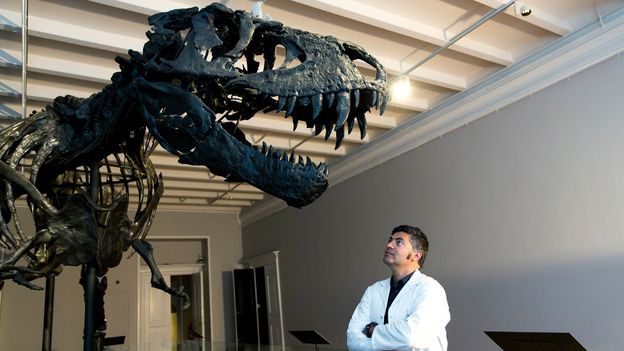Discovering the preserved remains of a once-living creature entombed within stone for millions of years is as fascinating as it is special. But Richard Fisher wonders if there is a way of increasing our own chances of being fossilised – and unearthed in ages to come.
Sitting on my desk as I write this is a trilobite – a woodlouse-like creature with bulbous eyes, spindly legs and a head like a horseshoe crab. I'm glad that it died millions of years ago, because if it was alive now, it would probably freak me out. I suspect it was a creature that scuttled.
I've been fascinated by fossils like this since I was a child, collecting several ammonites, a flattened fish, a dinosaur vertebrae and various other organisms of the deep past. What I love about them is how they can transport the mind away from the present: each one is a window to a time and place that no longer exists. Looking at these ancient creatures – trying to imagine how they lived, moved and behaved – I have often wondered what palaeontologists in the far future might make of the fossils of the 21st Century: the blue whales, the elephants, the grizzly bears… the human beings.
This daydream has often led me to wonder: could I myself end up preserved and mineralised, like my pet trilobite?
...
For starters, I could try to get frozen somewhere cold and stable. After all, prehistoric people have been found inside Alpine glaciers, such as Oetzi, a man who lived around 5,000 years ago. Or I could go lie down in a desert cave, so long as I sealed myself off from scavengers. Ancient remains up to 10,000 years old have been found preserved in dry caves in Peru. And then there are peat bogs.
Occasionally a "bog body" is found in peat from thousands of years ago – sometimes the unfortunate victim of a ritual sacrifice, such as the Lindow man, discovered in north-west England in the 1980s. He lived around the same time as the Romans, and had his soft tissue preserved thanks to the sphagnum moss and the peat's unique chemical environment. For this, I wouldn't even have to travel far: among the nearest peat bogs to me are the mires of the New Forest, around 80 miles (125km) from London.
It would seem, then, that I'm spoilt for choice – would I want to be iced, mummified or peat-pickled?
...

 www.bbc.com
www.bbc.com
Sitting on my desk as I write this is a trilobite – a woodlouse-like creature with bulbous eyes, spindly legs and a head like a horseshoe crab. I'm glad that it died millions of years ago, because if it was alive now, it would probably freak me out. I suspect it was a creature that scuttled.
I've been fascinated by fossils like this since I was a child, collecting several ammonites, a flattened fish, a dinosaur vertebrae and various other organisms of the deep past. What I love about them is how they can transport the mind away from the present: each one is a window to a time and place that no longer exists. Looking at these ancient creatures – trying to imagine how they lived, moved and behaved – I have often wondered what palaeontologists in the far future might make of the fossils of the 21st Century: the blue whales, the elephants, the grizzly bears… the human beings.
This daydream has often led me to wonder: could I myself end up preserved and mineralised, like my pet trilobite?
...
For starters, I could try to get frozen somewhere cold and stable. After all, prehistoric people have been found inside Alpine glaciers, such as Oetzi, a man who lived around 5,000 years ago. Or I could go lie down in a desert cave, so long as I sealed myself off from scavengers. Ancient remains up to 10,000 years old have been found preserved in dry caves in Peru. And then there are peat bogs.
Occasionally a "bog body" is found in peat from thousands of years ago – sometimes the unfortunate victim of a ritual sacrifice, such as the Lindow man, discovered in north-west England in the 1980s. He lived around the same time as the Romans, and had his soft tissue preserved thanks to the sphagnum moss and the peat's unique chemical environment. For this, I wouldn't even have to travel far: among the nearest peat bogs to me are the mires of the New Forest, around 80 miles (125km) from London.
It would seem, then, that I'm spoilt for choice – would I want to be iced, mummified or peat-pickled?
...

How to turn yourself into a fossil
How can you increase your chances of becoming a fossil? Richard Fisher decided to find out.
